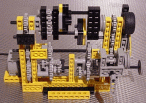
October 2005. This project is a successor of my first succesfull realization of a LEGO continuously variable transmission (CVT) with a wide range of transmissions and torques that was built in March 2004.
. 
The new CVT is smaller and features a new design for the planetry gear transmission and is a simulation of the hybrid car power trains that combine a fuel engin with an electro motor, a chargable battery and a generator. I have found a number of explanations for the working of these cars, the Honda Insight and Toyota Prius:
A comparison and vey nice explanation from Insight Cental
In my simulation of the hybrids is the fuel engin replaced by a Lego motor, while the combination of an electromotor, battery and generator is replaced by a crane construction. Potential energy is generated by pulling the weight and is released as kinetic energy by letting it come down. The next picture shows my first experiments with this idea.
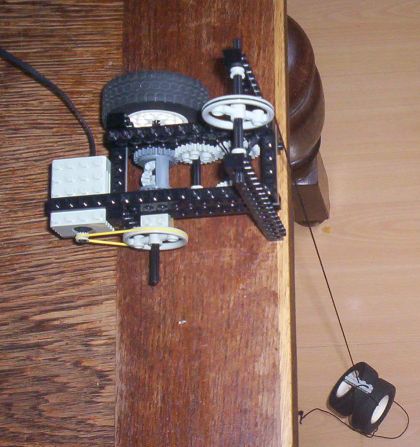
By blocking the wheel, a Lego rope is winded up and the weight will be pulled up. When the wheel is unblocked , it gets extra speed form the combined speeds of the legomotor and the unwinding of the rope. The lenghts of the rope relates to the maximum charge of the battery. The next picture shows the addition of a powersplitter to geta full simulation of the hybrid. The powersplitter, which is a planetary gear transmission is realized with the crone gear parts of 2 Lego differentials and 2 tri-star beams for supporing the planetary gears. The sun gear and the generator are in the left part of this construction. The planet carrier wheel and the motor part are in the right side of the construction. The fuel engin, simulated by an Lego electromotor, is connected to the central axis in the differentials that rotate the planet wheels.
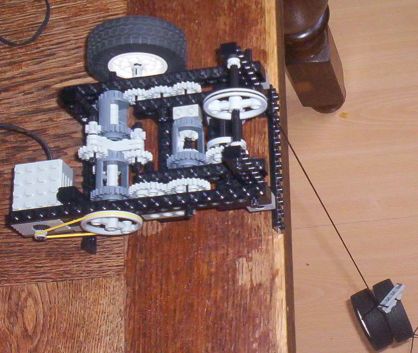
This construction didn't work well because the transmissions between the powersplitter, the generator and the motor were wrong. The fuel engin (the Lego motor) is slowed down when it is forced to charge the batey (to pull the weight), while the battery does nog get enough energy to drive the motor (th weight does not come down easily). The next pictures show a construction that realy works!
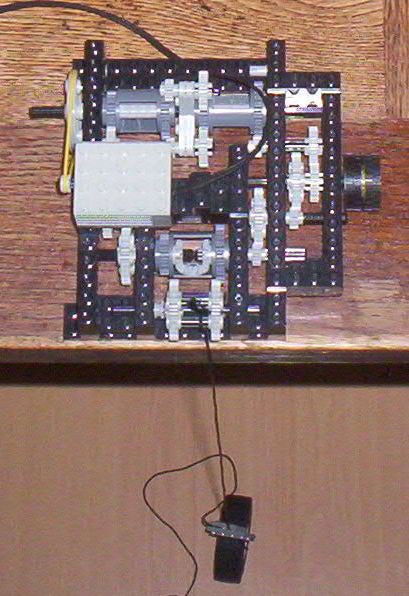
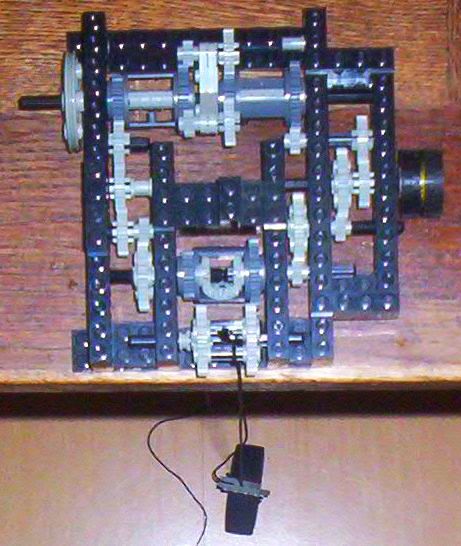
This constuction also shows CVT behaviour by playing with the load on the output wheel. When the output wheel is blocked, and the weigth is fully up, a torque is felt from a lego motor that is geared down 27 times. The total gear ratio of an unblocked output is 9. Higher output rotation speeds are reached when the weight is moving down.
The construction is small enough for a Lego car, except for the weight. Therefore , I started an experiment with Lego elastics.

Although the elastic gives the hybrid-CVT a clearly different dynamic behaviour it worked surprisingly well. The construction could be made smaller by winding the elastic over a number of Lego wheels. Then, of course I had to test this in a car as soon as possible.
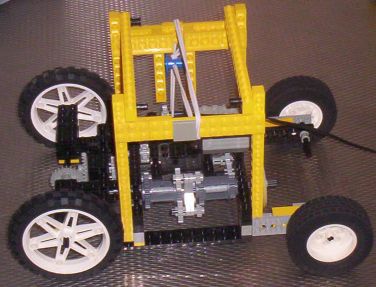
I admit, this is not a beatifull car, but it's a fact that this thing is my very first prototype of a LEGO hybrid CVT. From experiments with this car I got the impression that the power splitter is not effectively working in this range of forces and transmissions. When the car hits some object, the car simply stops and the elastic belt is gradually stretched to a point that the force is large enough to get the car moving. Nontheless, I hope, this will inspire many of you to experiment with CVT's and to get them working in nice LEGO model cars!
Please let me know if I can improve these pages with your comments or web-links and pictures? of your CVT creations. mail: Jurrien Bijhold
